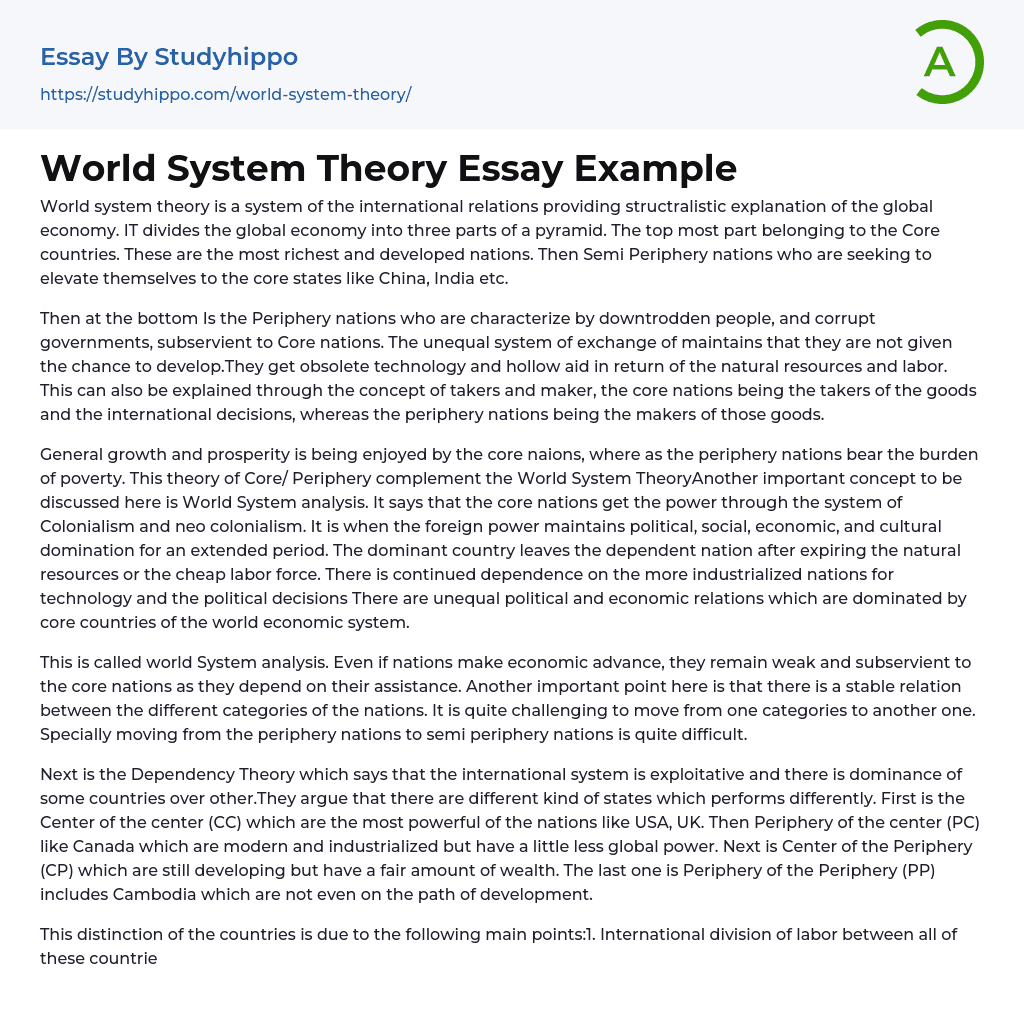World system theory is a system of the international relations providing structralistic explanation of the global economy. IT divides the global economy into three parts of a pyramid. The top most part belonging to the Core countries. These are the most richest and developed nations. Then Semi Periphery nations who are seeking to elevate themselves to the core states like China, India etc.
Then at the bottom Is the Periphery nations who are characterize by downtrodden people, and corrupt governments, subservient to Core nations. The unequal system of exchange of maintains that they are not given the chance to develop.They get obsolete technology and hollow aid in return of the natural resources and labor. This can also be explained through the concept of takers and maker, the core nations being the takers of the goods and the international decisions, whereas the pe
...riphery nations being the makers of those goods.
General growth and prosperity is being enjoyed by the core naions, where as the periphery nations bear the burden of poverty. This theory of Core/ Periphery complement the World System TheoryAnother important concept to be discussed here is World System analysis. It says that the core nations get the power through the system of Colonialism and neo colonialism. It is when the foreign power maintains political, social, economic, and cultural domination for an extended period. The dominant country leaves the dependent nation after expiring the natural resources or the cheap labor force. There is continued dependence on the more industrialized nations for technology and the political decisions There are unequal political and economic relations which are dominated by core countries of the world economic system.
This is
called world System analysis. Even if nations make economic advance, they remain weak and subservient to the core nations as they depend on their assistance. Another important point here is that there is a stable relation between the different categories of the nations. It is quite challenging to move from one categories to another one. Specially moving from the periphery nations to semi periphery nations is quite difficult.
Next is the Dependency Theory which says that the international system is exploitative and there is dominance of some countries over other.They argue that there are different kind of states which performs differently. First is the Center of the center (CC) which are the most powerful of the nations like USA, UK. Then Periphery of the center (PC) like Canada which are modern and industrialized but have a little less global power. Next is Center of the Periphery (CP) which are still developing but have a fair amount of wealth. The last one is Periphery of the Periphery (PP) includes Cambodia which are not even on the path of development.
This distinction of the countries is due to the following main points:1. International division of labor between all of these countries - The core countries dominate in terms of technology. The PP are like resource extraction economies providing cheap labor. The structure is PC serve CC, CP serves CP ad CC, PP serves everybody else.2. Class distinction - There is a clear division in rich and working class and is same for each of the countries.
They cooperate with one another to ensure they remain in power to keep the system the way it is.3. Global Capitalism –
According to this all structures exist within the wider global system. In this system, liberal economic theory trades in interest of core countries. Banks, international institutions, media serve interest of richest countries. This entire system serves the interest of the wealthy.
They do not promote equal distribution, rather promote dominance and dependency.Now the major drawback of following these system is that it is not sustainable. When the global economy becomes urbanized, then the cost of production will go up as there will be no cheap labor and the natural resources will be exhausted once the saturation point is reached.To be sustainable, the Core countries should also develop the other nations by being equal in the terms of trade and therefore give them a chance to grow rather than trap them in the circle of poverty.
- Policy essays
- Public Policy essays
- Totalitarianism essays
- Communism essays
- Conservatism essays
- Liberalism essays
- Marxism essays
- Socialism essays
- Activism essays
- Patriotism essays
- Social Contract essays
- Nationalism essays
- Malala essays
- American Dream essays
- Barriers To Entry essays
- Capitalism essays
- Central Bank essays
- Compensation essays
- Consumerism essays
- Economic Development essays
- Economic Growth essays
- Economic Inequality essays
- Economic System essays
- Economy essays
- Employment essays
- Export essays
- Finance essays
- Free Trade essays
- Gross Domestic Product essays
- Human Development essays
- Income Inequality essays
- Industry essays
- Inflation essays
- International Business essays
- International Trade essays
- Macroeconomics essays
- Materialism essays
- Max Weber essays
- Microeconomics essays
- Minimum Wage essays
- Monetary Policy essays
- Monopoly essays
- Pricing essays
- Profit essays
- Recession essays
- resources essays
- Taxation essays
- Trade essays
- Unemployment essays
- Warehouse essays




